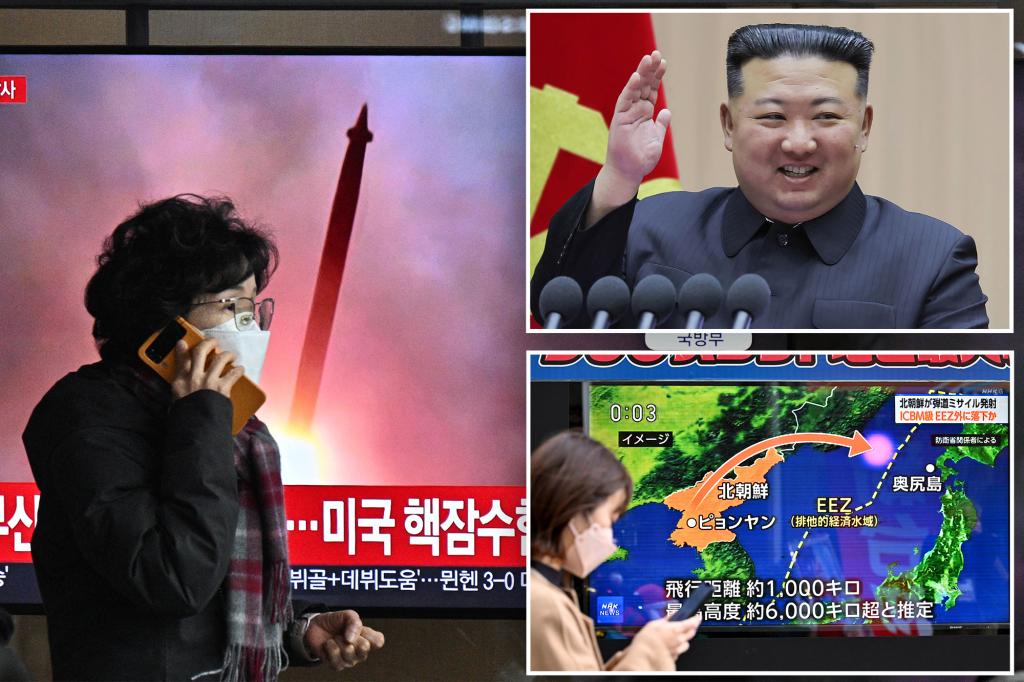North Korea launched an intercontinental ballistic missile on Monday that has the range to hit anywhere in the United States, South Korea and Japan said, marking the second launch in hours as Pyongyang denounced the US-led crackdown as a move of “war”.
The missile has the potential to travel more than 9,300 miles, meaning it could reach anywhere in Japan and the US mainland, Japanese Parliamentary Vice Minister of Defense Shingo Miyake said.
South Korea’s National Security Council said it was a solid-fuel intercontinental ballistic missile (ICBM), labeling the launch an destabilizing act that ignored international warnings and several UN Security Council resolutions.
President Yoon Suk Yeol has ordered the upgrading of effective “nuclear deterrence” operations by South Korea and the United States, he said in a statement.
Monday’s missile was fired from an area near the capital Pyongyang toward the sea off the North’s east coast and flew about 1,000 km, South Korea’s Joint Chiefs of Staff said.
A woman walks past a television screen showing a news broadcast with file footage of North Korea’s missile test at a train station in Seoul on Dec 18, 2023. AFP via Getty Images
Japan’s defense ministry reported the flight lasted 73 minutes, just short of the 74-minute flight by a North Korean ICBM fired in July.
It reached a maximum height of more than 3,730 miles and fell into the sea west of Hokkaido outside Japan’s exclusive economic zone, Japan said.
Such launches underscore the North’s efforts to advance its arsenal with long-range weapons that can potentially reach the United States mainland.
A pedestrian walks past a television screen showing a news report on North Korea’s missile launch in Tokyo on Dec 18, 2023. AFP via Getty Images
The area near the international airport serving Pyongyang is where the North has previously launched ICBMs and is suspected of being the location of a missile assembly facility.
The North’s latest solid-fuel Hwasong-18 ICBM was launched from near Pyongyang, on a grassland that analysts say is likely to be reinforced with concrete for the heavy launch vehicle.
Monday’s missile launch came after North Korea fired a short-range ballistic missile on Sunday night, flew about 354 miles and fell into the ocean.
North Korea’s launched missiles have the potential to travel more than 9,300 miles. AP
North Korea followed the launch with a fiery statement condemning the United States for orchestrating what it called a “preview of nuclear war,” including the arrival of a nuclear-powered submarine in South Korea on Sunday.
US SUBMARINE VISITS SOUTH KOREA
White House National Security Adviser Jake Sullivan spoke with his counterparts from South Korea and Japan and stressed the importance of sharing missile warning data, the White House said.
The three allies have been working to set up a real-time missile data-sharing system, but it is still “several days” from being operational, South Korea’s defense ministry said.
On Friday, following a high-level meeting by US and South Korean officials on the use of US strategic military weapons to deter North Korean military threats, Washington warned any nuclear attack would lead to the end of the regime.
Japanese Prime Minister Fumio Kishida enters his office in Tokyo on Dec. 18, 2023, shortly after North Korea fired a ballistic missile into the Sea of Japan. ZUMAPRESS.com
North Korea says it has the sovereign right to operate a ballistic missile program for self-defense and rejects a UN Security Council ban, which it says is a product of hostile US policy.
After Sunday’s launch, North Korea’s defense ministry criticized “military gangsters” in the United States and South Korea for raising tensions with drills, displays of force and plans for nuclear war.
The unnamed ministry spokesman’s statement cited the arrival of the US nuclear-powered submarine Missouri in the South Korean port city of Busan on Sunday.
Visits by US nuclear submarines were previously rare, but they have increased under an agreement between Seoul and Washington that has increased the deployment of US military assets.
The USS Carl Vinson, a US aircraft carrier, also arrived in Busan last month as part of efforts to boost deterrence against North Korea’s nuclear and missile programs.
North Korea’s defense ministry also condemned the meeting by South Korean and US officials in Washington as another sign of efforts to coordinate preparations for war and a provocative show of force.
The United States and South Korea have stepped up the intensity of joint military exercises against the growing threat from the North, which has tested multiple ballistic missiles and in November launched its first military spy satellite.
Categories: Trending
Source: thtrangdai.edu.vn/en/



